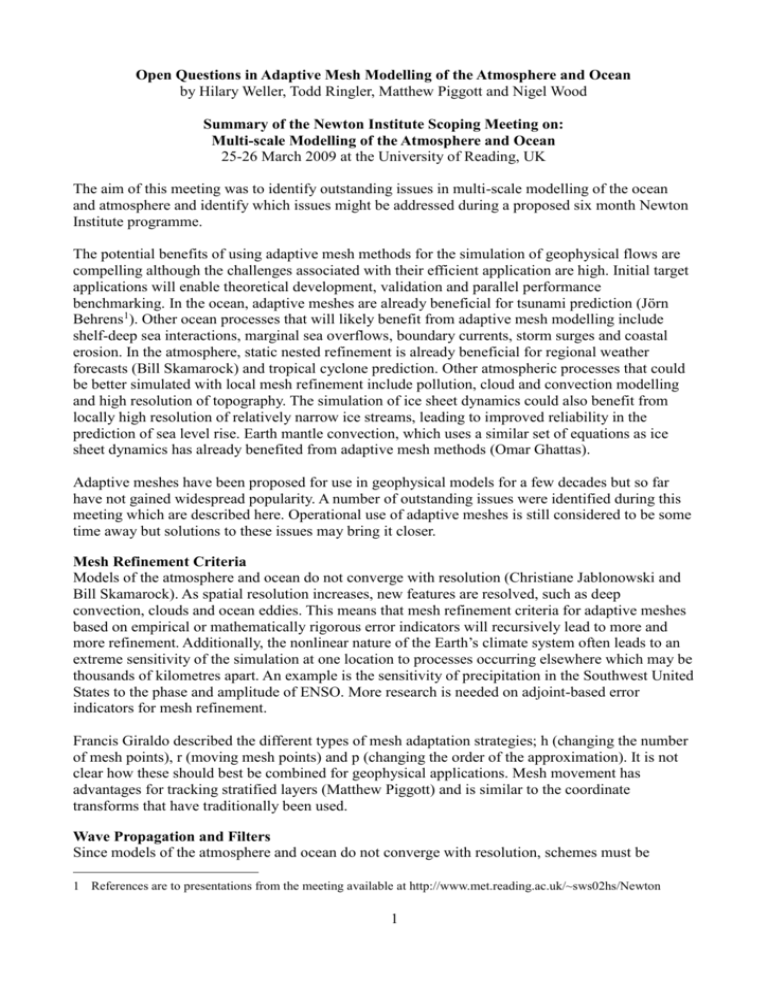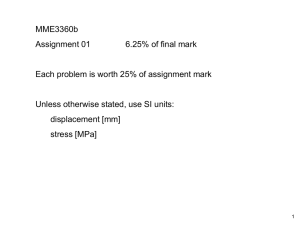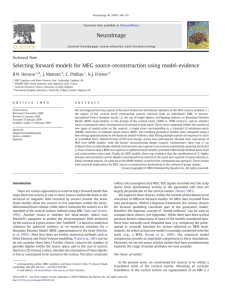Meeting Summary submitted to the Bulletin of the American
advertisement

Open Questions in Adaptive Mesh Modelling of the Atmosphere and Ocean by Hilary Weller, Todd Ringler, Matthew Piggott and Nigel Wood Summary of the Newton Institute Scoping Meeting on: Multi-scale Modelling of the Atmosphere and Ocean 25-26 March 2009 at the University of Reading, UK The aim of this meeting was to identify outstanding issues in multi-scale modelling of the ocean and atmosphere and identify which issues might be addressed during a proposed six month Newton Institute programme. The potential benefits of using adaptive mesh methods for the simulation of geophysical flows are compelling although the challenges associated with their efficient application are high. Initial target applications will enable theoretical development, validation and parallel performance benchmarking. In the ocean, adaptive meshes are already beneficial for tsunami prediction (Jörn Behrens1). Other ocean processes that will likely benefit from adaptive mesh modelling include shelf-deep sea interactions, marginal sea overflows, boundary currents, storm surges and coastal erosion. In the atmosphere, static nested refinement is already beneficial for regional weather forecasts (Bill Skamarock) and tropical cyclone prediction. Other atmospheric processes that could be better simulated with local mesh refinement include pollution, cloud and convection modelling and high resolution of topography. The simulation of ice sheet dynamics could also benefit from locally high resolution of relatively narrow ice streams, leading to improved reliability in the prediction of sea level rise. Earth mantle convection, which uses a similar set of equations as ice sheet dynamics has already benefited from adaptive mesh methods (Omar Ghattas). Adaptive meshes have been proposed for use in geophysical models for a few decades but so far have not gained widespread popularity. A number of outstanding issues were identified during this meeting which are described here. Operational use of adaptive meshes is still considered to be some time away but solutions to these issues may bring it closer. Mesh Refinement Criteria Models of the atmosphere and ocean do not converge with resolution (Christiane Jablonowski and Bill Skamarock). As spatial resolution increases, new features are resolved, such as deep convection, clouds and ocean eddies. This means that mesh refinement criteria for adaptive meshes based on empirical or mathematically rigorous error indicators will recursively lead to more and more refinement. Additionally, the nonlinear nature of the Earth’s climate system often leads to an extreme sensitivity of the simulation at one location to processes occurring elsewhere which may be thousands of kilometres apart. An example is the sensitivity of precipitation in the Southwest United States to the phase and amplitude of ENSO. More research is needed on adjoint-based error indicators for mesh refinement. Francis Giraldo described the different types of mesh adaptation strategies; h (changing the number of mesh points), r (moving mesh points) and p (changing the order of the approximation). It is not clear how these should best be combined for geophysical applications. Mesh movement has advantages for tracking stratified layers (Matthew Piggott) and is similar to the coordinate transforms that have traditionally been used. Wave Propagation and Filters Since models of the atmosphere and ocean do not converge with resolution, schemes must be 1 References are to presentations from the meeting available at http://www.met.reading.ac.uk/~sws02hs/Newton 1 developed which allow small scale features to propagate cleanly out of regions in which they are resolved into regions in which they are partially resolved without spurious wave reflection, refraction or scattering (Bill Skamarock, John Thuburn, Christiane Jablonowski and Terry Davies). This may be possible through the development of appropriate scale selective, anisotropic filters which operate over a transition zone adjacent to a coarser region of mesh (Bill Skamarock). Many ideas from the mathematical community are currently being considered, such as implicit filters, non-dissipative closures and limiters via Godunov or Riemann methods. Sub-grid scale parameterisations Many features of the Earth system will never be resolved within global models, such as cloud microphysics. Parameterisations for these processes will probably not need to change for use with adaptive meshes. However buoyant convection in the atmosphere occurs over a range of length scales which are often close to the mesh scale. Current parameterisations for atmospheric convection assume that the mesh is much coarser than the buoyant plumes – an assumption which is good only for mesh sizes above about 50km. However resolution used in weather and climate models is already at or well below 50km, and with ever more powerful computers we know that the model resolutions will continue to get finer. Most atmospheric models can be run stably without a convection scheme at resolutions below 1 or 2km. But the simulated up and downdraughts are not realistic until resolution reaches about 100 or 200m (Terry Davies). This resolution is unfeasible within a global model, even with adaptive resolution. A resolution dependent convection parameterisation scheme is therefore needed but there are currently no clear proposals on how such a scheme could be developed, despite efforts over the past four decades. Data assimilation It is not clear how to perform data assimilation in order to initialise a model on a multi-resolution mesh based on ever increasing amounts of observed data. It is frequently the case that building the data assimilation system is more difficult than building the forward model. Understanding how adaptive methods will interact with data assimilation methods is an important and urgent task. Preservation of balance, local conservation and monotonicity under adaptation Maintaining discrete analogues of balance, conservation and monotonicity is a topic that has been well tackled on fixed meshes but much less so when mapping solutions to a newly adapted mesh. The consequence of not preserving balance is that spurious waves are generated on adaptation which can contaminate the solution and may lead to runaway adaptation (John Thuburn). The consequence of not conserving mass is that, after many adaptations, sparse species can almost disappear (Matthew Piggott). And the consequence of not preserving monotonicity is that new unphysical peaks and troughs in solution variables could be created; especially problematic are unphysical negative concentrations. John Thuburn discussed mapping balanced variables instead of primitive variables in order to preserve balance. This would be more expensive as primitive variables (velocity, pressure, density etc) must be recovered by inverting elliptic equations, although it may well be inevitable as balance is a non-local phenomenon. Conservation is relatively straightforward when mapping fields between block structured meshes as the smaller cells fit exactly into the larger cells. However when mapping between unstructured meshes, all overlapping volumes between old and new meshes must be calculated to ensure that quantities are transferred without loss (Matthew Piggott). However, no work has been done on the preservation of all three constraints under adaptation. Equation Sets At coarse resolution, some terms in the full Navier-Stokes equations are insignificant and can be ignored. As resolution increases, all terms must be included at additional cost (Terry Davies and 2 Francis Giraldo). It may be beneficial in a multi-resolution mesh to exploit the efficiency gains of ignoring terms of the equations where the mesh is coarse. The validity of this approach should be assessed and appropriate transitions between flow regimes need to be found. Computational efficiency, parallelisation and time stepping Weather and climate forecasts have very tight efficiency constraints, for example the supercomputing time slot for a one day global weather forecast at the UK Met Office is six minutes (Terry Davies). Adaptive meshing inevitably comes at some computational cost and it is essential to demonstrate that adaptive methods can be more computationally efficient than current operational models for the same prediction skill. Since increases in computing power requires the efficient use of more and more processors, it is essential that new algorithms are highly scalable. Techniques have been developed which optimise parallelisation of adaptive meshes (Jörn Behrens and Omar Ghattas) by using structured refinement (maintaining children of coarse cells and parents of fine cells) and ordering cells using space filling curves. Unstructured mesh methods make small local changes to the domain decomposition to ensure a balanced load while minimising data migration (Matthew Piggott). It is clear that the use of explicit time stepping can be used in conjunction with algorithms that are scalable to 100s of thousands of processors (Bill Skamarock) but explicit time stepping comes at the expense of very small time steps dictated by the speed of the fastest explicitly-resolved waves (usually acoustic). Omar Ghattas showed how algebraic multigrid implicit solvers can scale to 10s of thousands of processors for mantle convection applications. It is not clear how parallelisable semi-implicit time stepping for atmosphere and ocean simulations can be. It inevitably requires global communication which intrinsically slows parallel performance. But the longer stable time steps that may be taken can make semi-implicit time stepping beneficial (Francis Giraldo). The accuracy advantages of explicit versus semi-implicit time stepping are also not well understood. More demanding test cases Many novel numerical methods perform outstandingly well on simple test cases. However, when diabatic processes are included, results can deteriorate dramatically (Bill Skamarock). More demanding test cases for the atmosphere should include directly the small scale diabatic affects of moisture. Test cases for the ocean should be three-dimensional and at basin scale. 3









